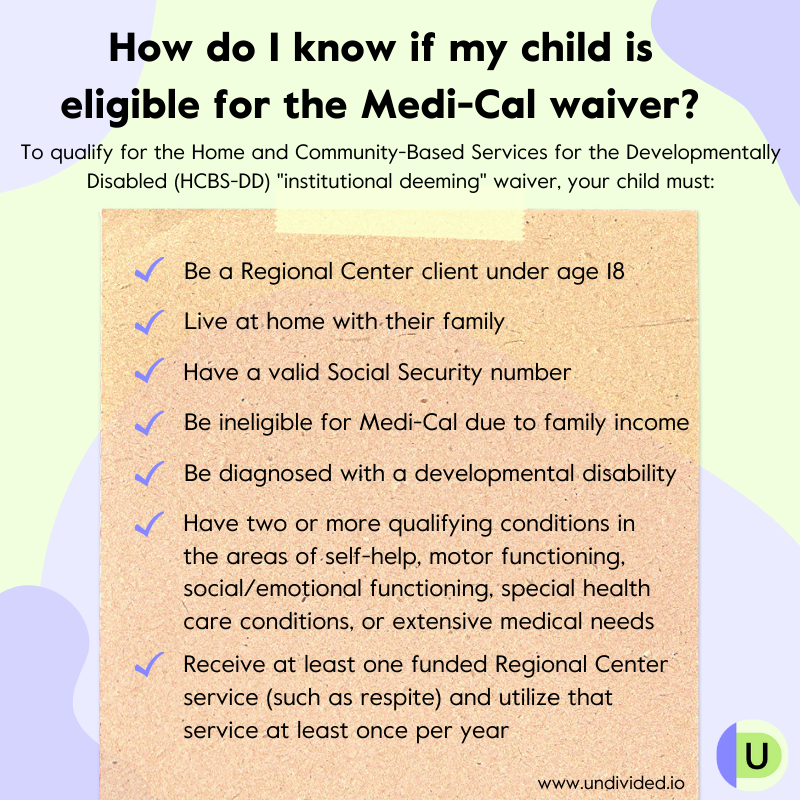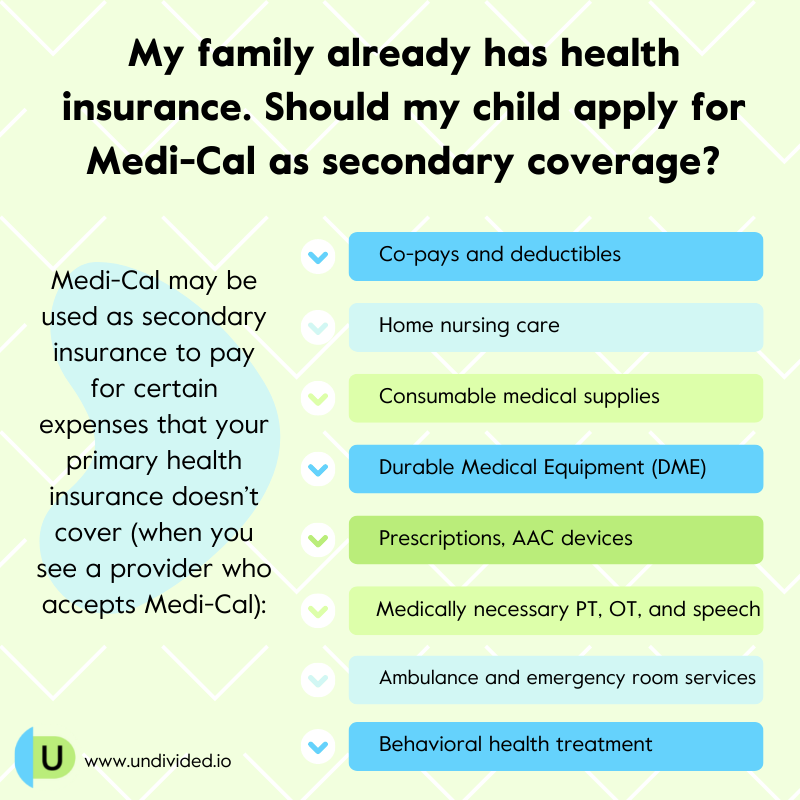Medi-Cal 101
What services does Medi-Cal provide?
Common Medi-Cal services include (but are not limited to):
- Medical coverage
- Physical, occupational, and speech therapy when medically necessary
- Applied Behavioral Analysis (ABA)
- Equipment and supplies
- Incontinence supplies
Medi-Cal for children is administered through the Early and Periodic Screening, Diagnostic and Treatment (EPSDT) benefit. Some services that are not available to adults with Medi-Cal may be available under EPSDT; for example, vision and dental care are covered for children under Medi-Cal.
Medi-Cal does much more than pay for health care costs. It can also qualify your child for certain government benefits that they could not access otherwise. For example, an individual must be enrolled in Medi-Cal to receive In-Home Supportive Services (IHSS).
Medi-Cal also helps to pay for a number of services, including:
- Respite
- Tailored day services
- Transportation
- Skilled nursing
- Behavioral supports
- Housing and vehicle modifications
- Day programs
- Social skills therapy
- Neuropsychology services
You can find much more information about these services in our Medi-Cal Terms and Services Glossary.
Note that Medi-Cal is the payer of last resort, which means that all other health plans you may be enrolled in — such as private insurance, a group health plan, or a managed care organization — are legally required to pay for their part of any claims before Medi-Cal will pay anything.
✅ Did you know you may be able to get discounts on your utility bills if you use in-home medical equipment? Check out our article for information about the Medical Baseline Allowance program and other utility discounts available to Medi-Cal recipients.
Who is eligible for Medi-Cal?
Eligibility for Medi-Cal is usually based on household income. However, California offers several programs that allow people with disabilities to obtain Medi-Cal if their income is too high to qualify based solely on financial need.
The program most often utilized by the families of children with developmental disabilities is the institutional deeming waiver, or Home and Community-Based Services for the Developmentally Disabled (HCBS-DD) waiver. This program allows many children who are Regional Center clients to receive Medi-Cal without regard to family income. For children with private health coverage, Medi-Cal coverage will be considered secondary insurance and may cover out-of-pocket expenses when you see a provider who accepts Medi-Cal.
If a child doesn't qualify for Regional Center, they may still be able to access Medi-Cal through the Home and Community Based Alternatives (HCBA) waiver.
Other programs to help Californians access Medi-Cal include the Medically Needy Share of Cost Program, the Aged and Disabled Federal Poverty Level program, and the 250% Working Disabled Program, which may be useful for young adults with disabilities whose monthly income is too high for the other programs.
Types of Medi-Cal
Medi-Cal as primary coverage
Most children with Medi-Cal as primary coverage will be enrolled in a Medi-Cal managed care plan. Available plans vary depending on your county. For example, in Los Angeles County, managed care plans include HealthNet and LA Care or a contracted plan under LA Care, such as Anthem Blue Cross, Blue Shield of California Promise Health Plan, and, under limited circumstances, Kaiser Permanente (usually for existing or recent Kaiser members).
These plans operate like any other managed care plan. You will receive an enrollment packet and both a Benefits Identification Card (BIC) and a managed care health plan card, along with instructions for finding in-network providers. New Medi-Cal recipients are encouraged to call Health Care Options and select a plan. If they fail to do so, one will be chosen for them.
NOTE: As of January 1, 2024, Kaiser Permanente has its own contract with the state and will no longer be contracted under LA Care. Current Kaiser Medi-Cal patients should be transferred to the Kaiser state plan and should not need to take further action. New recipients will be permitted to select Kaiser Medi-Cal coverage if they are current Kaiser members, have been a Kaiser member in the past 12 months, or have a Kaiser member in their immediate family. Current and former foster youth and recipients eligible for both Medicare and Medi-Cal will also be able to choose Kaiser.
There are some great online resources to help you choose the right managed care plan as your child’s sole insurance coverage. You can use the California Department of Health Care Services (DHCS) to:
- Compare up to three health care or dental plans.
- Find information on standard benefits, pharmacies, urgent care centers, and more.
- Search for a specific provider or hospital to see if they accept a Medi-Cal managed care plan.
- Get contact information for each provider.
Medi-Cal as secondary coverage
Families who already have health insurance coverage for their child can still benefit from Medi-Cal, as it may be used as a secondary insurance to pay for certain expenses that your primary health insurance doesn’t cover.
If a child has multiple insurance plans, Medi-Cal is always the last provider to be billed. For most beneficiaries, this means Medi-Cal will be your secondary insurance. You can read all about using Medi-Cal as secondary health coverage in this article.
Note that until recently, families with secondary Medi-Cal coverage were exempt from enrolling in a Medi-Cal managed care plan. This changed effective January 1, 2023.
How to get started
- If your child is not currently enrolled in Medi-Cal, you can create an account on BenefitsCal to start an application for your child.
- If your child is a Regional Center client, there are a few extra steps to enrolling via the HCBS-DD waiver, so be sure to see our article with instructions and tips.
- If your child is not a Regional Center client but does have complex medical needs, see this article for enrolling in Medi-Cal via the HCBA waiver.
The Undivided app has step-by-step guides for applying for Medi-Cal benefits via each of these methods, so create an account if you haven’t already to get started.
Apply for Medi-Cal based on household income (not waiver)
Apply for the Medi-Cal waiver (HCBS-DD)
Enroll in Medi-Cal using the HCBA waiver
What to do when Medi-Cal denies a claim
If Medi-Cal denies coverage for something your child needs, you are entitled to an appeal. An appeal is used when your care plan has taken an Adverse Benefit Determination (ABD), or an action “that affects your care, such as delay, modification, denial, or reduction of services, denial or only partial payment for a service, or the determination that the requested service was not a covered benefit.”
If you’re on a managed care plan, contact your plan’s customer service number. If this does not resolve the problem, you can file an appeal with your care plan. For more information, see our full article The Medi-Cal Appeal Process. To get assistance with an appeal, you can contact the Medi-Cal Managed Care and Mental Health Office of the Ombudsman. We also have step-by-step walkthroughs to guide you through the process:
Appeal my Medi-cal decision
Treatment Authorization Requests (TARs)
Some services and medications require prior authorization by Medi-Cal. The provider will submit the TAR and check its status. If the TAR is denied and you disagree with the decision, you may be able to request a fair hearing or state hearing.
If a managed care plan does not contract with any providers for a service that is medically necessary and is otherwise covered by Medi-Cal, recipients may request a TAR via fee-for-service Medi-Cal. For example, if your doctor has ordered home LVN care for your child but your managed care plan does not contract with any home health agencies, the service may be accessed through fee-for-service Medi-Cal instead. The managed care plan remains the starting point for initiating this process as they will need to provide documentation that they don't contract for the service.
Get help with Medi-Cal
Do you still have questions about Medi-Cal? Undivided members can attend regular office hours with Public Benefits Specialist Lisa Concoff Kronbeck to ask questions directly, so if you're not a member yet, get started here!
Join for free
Save your favorite resources and access a custom Roadmap.
Get StartedAuthor




